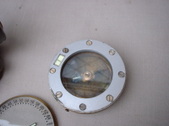-
 COMPASS, PRISMATIC, Mk3 (by Peter Laidler)
COMPASS, PRISMATIC, Mk3 (by Peter Laidler)
Last edited by Badger; 01-02-2011 at 01:59 PM.
-
The Following 6 Members Say Thank You to Badger For This Useful Post:
-
01-02-2011 01:49 PM
# ADS
Friends and Sponsors

-
For those who weren't following it at the time, this article links back nicely to the following thread also abotu the MkIII compass.
Just got my MkIII Compass back from Trademark London
Last edited by Badger; 01-02-2011 at 03:19 PM.
Reason: Edited post to show link with description ....
Союз нерушимый республик свободных Сплотила навеки Великая Русь. Да здравствует созданный волей народов Единый, могучий Советский Союз!
-
Thank You to Claven2 For This Useful Post:
-
-
I forgot to say in the article but if you are going to replace ANYTHING on your compass, especially those odd missing screws, then dont forget to check that they are NON FERROUS. They must not contain iron. Only bras- like material will do. Otherwise the sensitive magnetic pointer will go haywire and you'll never meet that RV point in the desert in a hundred years!
-
-
I may be mistaken, but is the new Stanley G150 production not using aluminum housings now?
Союз нерушимый республик свободных Сплотила навеки Великая Русь. Да здравствует созданный волей народов Единый, могучий Советский Союз!
-
-
Nope, Maybe for the commercial world but these looks brass to me!
-
-
Fair enough, though this assumes UK MOD is still buying new Stanleys - they may be, I'm not sure?
MOD is still buying new Stanleys - they may be, I'm not sure?
Союз нерушимый республик свободных Сплотила навеки Великая Русь. Да здравствует созданный волей народов Единый, могучий Советский Союз!
-
-
OK, I just figured out what I'm talking about - lol. Stanley stopped making the 150 a few years ago and according the the SIRS website:
The G150 Prismatic Compass, previously manufactured by W F Stanley, is now produced in the
UK
by SIRS Navigation Ltd.
It is made of brass and always has been.
http://www.sirs.co.uk/G150%20Marching%20Compass.htm
Now on the other hand, the Francis Barker MkIII, of which the G150 was a copy, evolved into the M73 compass and is still made by Pyser, who now owns Francis Barker. I suspect Stanley got away with making the G150 as the patents have likely expired. Pyser also makes the M88 which is an aluminum M73, or in our way of thinking, an aluminum MkIII with tritium lights and no compass cardinal points engraved on the outside of the case.
From what I understand, Pyser considerd the M73 nearly indestructible, serviceable, and in essence it can be made to work forever given time, money and parts. The M88, on the otehr hand, they consider disposable once the kerosene leaks out of it.
http://www.pyser-sgi.com/productdeta...?ProductID=321
I have no idea if UK MOD uses the M88 or just the M73, MkIII and G150.
In terms of fluid, Stanley filled (and now SIRS Nav) their compasses with Isopropanol while all the Francis Barker and Pyser compasses used purified kerosene when new. I understand UK MOD practise is to rebuild the latter with Isopropanol when they come in for repair.
Союз нерушимый республик свободных Сплотила навеки Великая Русь. Да здравствует созданный волей народов Единый, могучий Советский Союз!
-
Thank You to Claven2 For This Useful Post:
-
Legacy Member

Thanks Peter...changed out my fluid, got rid of my air bubble. Thanks so very much.
-
Thank You to newbieDAN For This Useful Post:
-
Bouletbill and another have asked about doing the same thing with a pair of old No2 Mk2 or 3 binoculars. I COULD but to be really honest, once they're back together you'll need to collimate the two sides. This is because each side of the binoculars is in fact a prismatic telescope. You've all looked through a pair of cheap/rubbish binoculars where you see two distinct images and they'll never merge into one. At the same time they'll give you a severe brain or head ache. That's collimation error for you and you need a light box collimator to set the eccentric OG lenses to merge the images.
There is a way to do it by eye but it's hard learned knack and even harder to explain
The next 'problem' is that the reticle lines are etched onto an optical glass plate. So fine that they are almost invisible. So can you imagine the problems cleaning the plate, on both sides! It's difficult, even in a clean room...... The smallest spec of anything looks like a huge lump of coal
-
The Following 2 Members Say Thank You to Peter Laidler For This Useful Post:
-
Too bad really, those binos can still be found for very reasonable prices.
Союз нерушимый республик свободных Сплотила навеки Великая Русь. Да здравствует созданный волей народов Единый, могучий Советский Союз!
-

member Peter Laidler
, a new article has been added to the Technical Articles for Milsurp Collectors and Re-loaders (click here).
(Click PIC to Enlarge)
(Click PIC to Enlarge)



















 PM
PM







